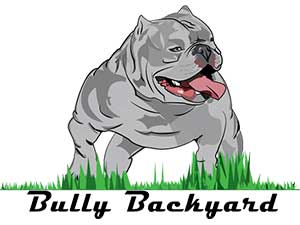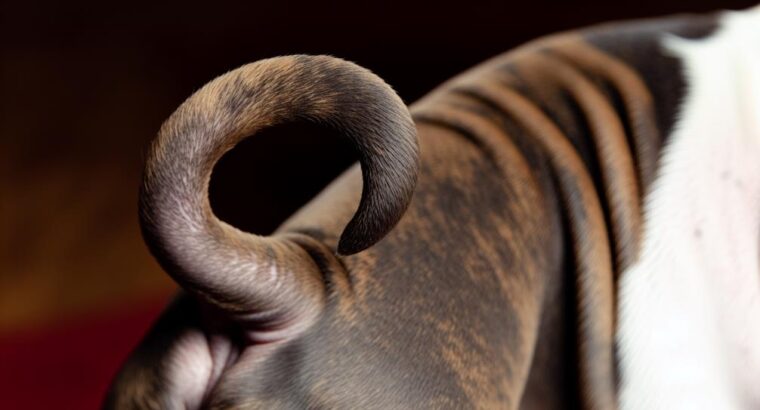American Bully Kinked Tail
The presence of a kinked tail in the American Bully breed raises important considerations regarding breed standards and responsible breeding practices.
Beyond its aesthetic implications, a kinked tail can signify underlying health concerns and genetic predispositions that warrant further examination.
Exploring the intricacies of this trait can shed light on broader issues within the breed, prompting reflection on how breeders and enthusiasts navigate these complexities to safeguard the integrity of the American Bully lineage.
The American Bully Breed Overview
Embodying a confident and amiable temperament, the American Bully breed emerges as a notable companion known for its lively nature and willingness to please.
Despite their robust appearance, American Bullies have a gentle disposition, making them excellent companions for families, including children, and displaying friendliness towards strangers, other animals, and fellow canines.
In the show ring, American Bullies stand out with their compact to medium-sized bodies, boasting well-rounded ribs, a broad chest, and strong, straight forelegs. These dogs adhere to a breed standard that highlights a heavy, broad head with pronounced cheek muscles and a medium-length, deep skull.
While American Bullies typically have straight tails, some individuals may exhibit kinked tails, also known as crooked tails, which deviate from the norm. Despite this deviation, the breed's overall appeal and characteristics remain unchanged, solidifying their reputation as loving and loyal companions.
Understanding the Kinked Tail Trait
The presence of kinked tails in American Bully dogs can be attributed to various factors, including genetic influences and potential injuries. Genetic factors, particularly from English Bulldog lineage, play a significant role in the occurrence of kinked tails in this breed. Additionally, trauma or injuries such as accidentally stepping on the tail can lead to the development of a kinked tail in American Bully dogs.
In the show ring, kinked tails are considered a fault for American Bully dogs, highlighting the importance of breeding standards in maintaining the breed's integrity. Ethical breeding practices aim to eliminate faults like kinked tails to guarantee the health and conformation of future generations of American Bully dogs. It is vital to note that dogs with kinked tails may not be suitable for breeding purposes due to the potential genetic implications associated with this trait. Understanding the various factors contributing to the kinked tail trait in American Bully dogs is essential for breeders and owners alike.
Genetic Factors Behind Tail Kinking
The manifestation of kinked tails in American Bully dogs stems from a complex interplay of approximately 20 hereditary factors influencing the development of the vertebral column, with mutations in genes being a key contributor to this skeletal deformity. These hereditary factors can interact in various ways, leading to abnormalities in the structure of the tail.
Mutations in specific genes involved in spinal development can disrupt the normal formation of vertebrae, resulting in a kinked tail phenotype. Line breeding practices, which involve breeding closely related dogs, can exacerbate the expression of these genetic factors, increasing the likelihood of kinked tails in offspring.
Responsible breeding practices are important in mitigating the incidence of kinked tails in American Bully dogs. Breeders should avoid mating dogs with known skeletal defects, including kinked tails, to prevent the perpetuation of these genetic abnormalities. Understanding the genetic underpinnings of tail kinking is essential for developing strategies to minimize its occurrence in the American Bully breed.
Impact on American Bully Health
Indicative of potential health issues in the spine and other skeletal areas, kinked tails in American Bullies can serve as critical markers for genetic abnormalities impacting the overall well-being of the breed. Dogs with kinked tails may experience discomfort or pain due to misalignment or malformation of the vertebrae, leading to possible mobility issues. These skeletal defects can also affect the nervous system, potentially causing neurological complications. Moreover, the presence of kinked tails in American Bullies is often linked to a higher likelihood of passing on skeletal abnormalities to their offspring, perpetuating health concerns across generations.
Breeding American Bullies with kinked tails can exacerbate these health problems, posing significant risks to the well-being of future litters. Thus, it is important for breeders and judges in dog shows to pay close attention to such genetic markers to maintain the health standards of the breed. By identifying and addressing kinked tails and other skeletal defects early on, proactive measures can be taken to safeguard the health and longevity of American Bullies.
Breeding Considerations for Kinked Tails
In evaluating breeding choices for American Bullies with kinked tails, the consideration of genetic implications and long-term health outcomes is pivotal. Kinked tails are deemed a fault in the show ring, affecting a dog's eligibility for competitions. Due to the hereditary nature of this trait, breeding a dog with a kinked tail may not be advisable. It is essential to assess the conformation of a dog with a kinked tail, both for showing and breeding purposes.
Responsible breeding practices should prioritize the elimination of faults like kinked tails to enhance the overall breed quality. Dogs with kinked tails may not be suitable for breeding purposes to prevent the transmission of genetic issues to future generations. By being diligent in selecting breeding pairs without kinked tails, breeders can work towards maintaining the health and standard conformation of the American Bully breed.
Ultimately, breeding decisions should prioritize the long-term well-being and genetic soundness of the dogs.
Common Myths and Misconceptions
Misconceptions surrounding kinked tails in American Bullies often lead to misunderstandings about their causes and implications. One common myth is that kinked tails are solely the result of injury or trauma. While trauma can cause kinks in a dog's tail, genetic factors can also play a significant role.
Additionally, some individuals mistakenly believe that kinked tails can be easily straightened or fixed through procedures, which is not always the case. Another misconception is that kinked tails always cause pain or discomfort to the dog. In reality, the level of discomfort can vary depending on the severity of the kink.
Moreover, there is a false assumption that kinked tails are always indicative of abuse or neglect, when in fact, they can occur naturally. To conclude, it is a myth that all dogs with kinked tails are unsuitable for adoption or loving homes. Understanding the truth behind these misconceptions is important in dispelling myths and promoting accurate knowledge about kinked tails in American Bullies.
Tail Care Tips for American Bullies
When it comes to caring for your American Bully's tail, regular inspection and gentle cleaning are essential practices to maintain their tail health. Start by regularly checking your Bully's tail for any signs of injury, redness, swelling, or discomfort.
Gently clean the tail area with a damp cloth to remove dirt, debris, or any potential irritants that could lead to infections. It's important to avoid pulling or tugging on your Bully's tail, as this can cause further damage or pain.
Ensuring a comfortable and safe environment for your American Bully is also significant to prevent tail injuries during play or exercise. If you notice any changes in your dog's tail, such as unusual swelling, discharge, or persistent pain, it's advisable to consult with a veterinarian promptly.
Consulting a Veterinarian for Tail Abnormalities
Have you noticed any abnormalities in your American Bully's tail that concern you? If you observe a kinked tail or any other irregularity, it is essential to consult a veterinarian promptly. Veterinarians possess the expertise to evaluate the severity of the tail abnormality and recommend suitable treatment options.
Tail abnormalities in American Bullies can sometimes be indicative of underlying health issues that require professional assessment and management. By seeking veterinary guidance, you can guarantee proper care for your pet and address any discomfort or potential complications associated with a kinked tail.
Early intervention by a veterinarian is essential in safeguarding your American Bully's well-being and promoting a healthy lifestyle. Remember that veterinarians are equipped to offer tailored advice on how to best manage the situation and support your dog through any necessary treatment protocols.
Prioritizing veterinary consultation is key in addressing tail abnormalities and ensuring the best health of your beloved American Bully.
Embracing Your American Bully's Uniqueness
Embracing the unique characteristics of your American Bully, including their kinked tail, is essential for fostering a deeper appreciation of their individuality and strengthening the bond between you and your beloved pet. Understanding that a kinked tail is a distinguishing feature rather than a health concern is important. By celebrating your American Bully's individuality and loving them unconditionally, kinked tail and all, you communicate acceptance and promote a positive self-image for your pet.
Additionally, educating others about your American Bully's kinked tail can help foster acceptance and appreciation for diversity within the canine community. It's important to emphasize that a kinked tail does not diminish the value or worth of your American Bully as a cherished companion. By showcasing your acceptance and pride in your Bully's unique traits, you set an example for others to embrace differences and see the beauty in diversity. Ultimately, by embracing your American Bully's uniqueness, you not only enhance your bond with your pet but also contribute to a more inclusive and understanding environment for all dogs.
Conclusion
To sum up, responsible breeding practices in the American Bully breed should prioritize the elimination of faults such as kinked tails to maintain the health and well-being of future generations.
Genetic factors play a significant role in the occurrence of kinked tails, and thorough assessment of conformation is essential in breeding decisions.
Consulting a veterinarian for tail abnormalities and providing proper care are vital steps in ensuring the overall quality of American Bullies.

